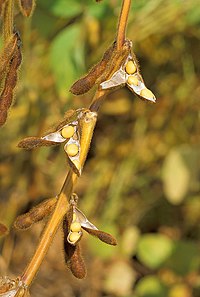
Photo from wikipedia
Soybean cyst nematode (SCN; Heterodera glycines; HG) is a widely occurring and damaging pathogen that limits soybean production. Developing resistant cultivars is the most cost-effective method for managing this disease.… Click to show full abstract
Soybean cyst nematode (SCN; Heterodera glycines; HG) is a widely occurring and damaging pathogen that limits soybean production. Developing resistant cultivars is the most cost-effective method for managing this disease. Genes conferring SCN resistance in soybean have been identified; however, there are SCN populations that overcome known resistance genes. In order to identify additional sources of resistance and potentially new resistance genes, 223 plant introductions (PIs) of G. tomentella and 59 PIs of 12 other perennial Glycine species were inoculated with HG Types 0, HG 2, and HG 1.2.3, and then 36 PIs out of this set were further evaluated with HG Type 1.2.3.4.5.6.7, a population that overcomes all the resistance genes in soybean. Of 223 G. tomentella PIs evaluated, 86 were classified as resistant to three HG types, 69 as resistant to two HG types, and 22 as resistant to one HG type. Of the other 12 perennial Glycine species, all PIs of G. argyrea and G. pescadrensis were resistant to all three HG types. Of the 36 PIs challenged with HG Type 1.2.3.4.5.6.7, 35 were resistant with 16 showing no cyst reproduction. Our study confirms that there are high levels of resistance to SCN among the perennial Glycine species. This represents an untapped resource for use in genetic studies and for improving resistance to SCN in soybean.
Journal Title: Plant disease
Year Published: 2017
Link to full text (if available)
Share on Social Media: Sign Up to like & get
recommendations!